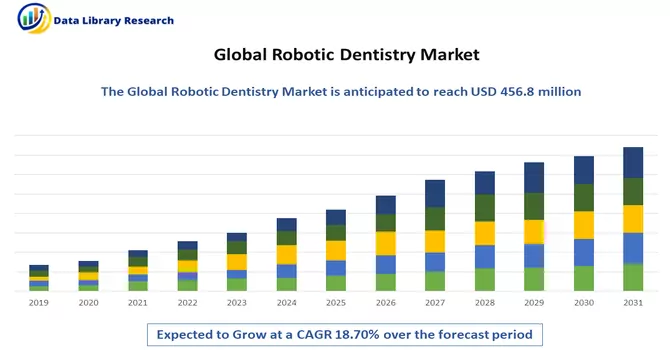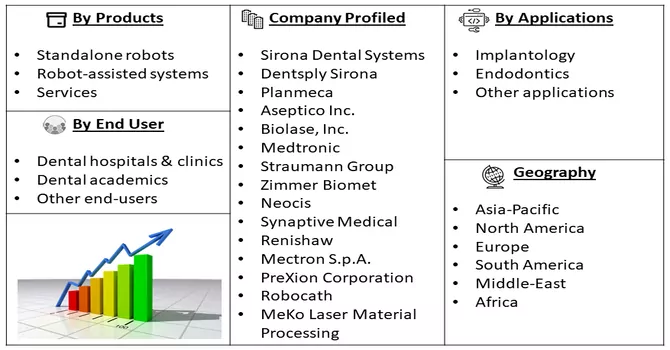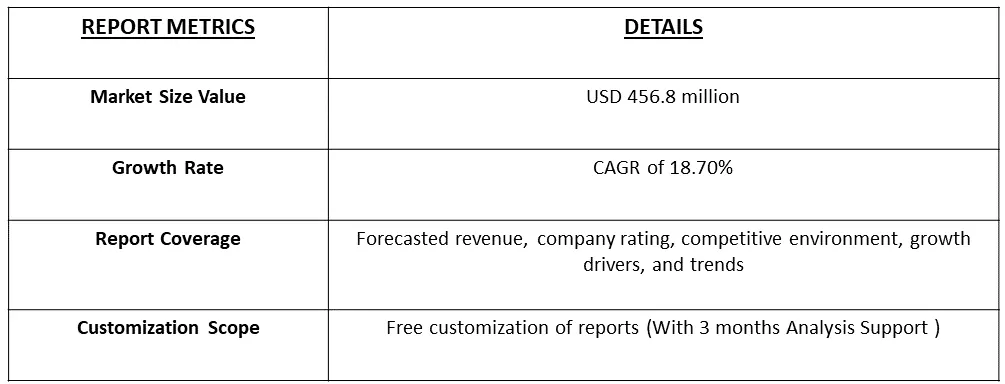The global robotic dentistry market size was estimated at USD 456.8 million in 2023 and registered a CAGR of 18.70% during the forecast period from 2024 to 2031.

Get Complete Analysis Of The Report - Download Free Sample PDF
Robotic dentistry refers to the integration of robotic systems and technologies into dental procedures and practices. This innovative approach involves the use of robotic devices, automation, and artificial intelligence to assist or perform various dental tasks, enhancing precision, and efficiency, and potentially improving patient outcomes. Robotic dentistry aims to bring advancements to traditional dental procedures by leveraging cutting-edge technologies in the field of robotics. Key components of robotic dentistry may include robotic arms, haptic feedback systems, computer-aided design and manufacturing (CAD/CAM) technology, and artificial intelligence algorithms. These technologies can be applied in various aspects of dentistry, such as diagnostics, surgery, and prosthetics.
The market for robotic dentistry is driven by several key factors that reflect the growing adoption and advancements in this innovative field. These driving factors contribute to the expansion of robotic technologies in dental practices and procedures. Robotic dentistry offers high precision and accuracy in dental procedures, ensuring meticulous execution of tasks such as surgery, implant placement, and prosthetic fabrication. This enhanced precision is a significant factor attracting both dentists and patients. Moreover, the use of robotics in dentistry contributes to improved patient outcomes by enhancing the predictability and success rates of procedures. This factor is compelling dental professionals to integrate robotic technologies into their practices. Thus, these driving factors are expected to drive the growth of the studied market over the forecast period.
The robotic dentistry market is witnessing a surge in the adoption of robot-assisted procedures across various dental applications. Dental professionals are increasingly integrating robotic systems for enhanced precision and efficiency in surgeries and other dental interventions. Robotic dentistry is experiencing a notable trend in expanding its applications, particularly in implant dentistry. Robotic systems are being utilized for precise implant placement, contributing to improved success rates and patient outcomes. Furthermore, the market for robotic dentistry is experiencing global expansion. Emerging economies are becoming key growth markets as the adoption of advanced dental technologies, including robotics, becomes more widespread, driven by increasing awareness and investments in healthcare infrastructure. Thus, these market trends collectively reflect the dynamic nature of the robotic dentistry landscape, showcasing advancements, collaborations, and a growing focus on patient-centric approaches that are reshaping the future of dental care.
Market Segmentation: The Robotic Dentistry Market is Segmented by Products and services (Standalone robots, Robot-assisted systems, Services), Applications (Implantology, Endodontics, and Other applications), End-users (Dental hospitals & clinics, Dental academics, Other end-users) and Geography (North America, Europe, Asia-Pacific, and Rest of the World). The value is provided (in USD million) for the above segments.

For Detailed Market Segmentation - Download Free Sample PDF
Market Drivers:
Growing Minimally Invasive Procedures and Demand for Dental Implants
Minimally invasive dental procedures have emerged as a transformative trend in modern dentistry, reshaping treatment approaches and significantly influencing the demand for dental implants. This evolution is driven by a convergence of factors that prioritize patient comfort, swift recovery, and enhanced treatment outcomes. The increasing patient awareness and a preference for less invasive interventions have fueled the demand for minimally invasive dental procedures. Patients often seek treatments that minimize discomfort, reduce recovery times, and offer a more pleasant overall experience. Furthermore, the increasing need for dental implants, a widely adopted remedy for tooth loss, harmonizes seamlessly with the capabilities of robotic dentistry. Robotic systems bring unmatched precision to the placement of implants, guaranteeing optimal positioning critical for long-term success. As the worldwide population seeks advanced and effective dental solutions, the incorporation of robotic technology not only caters to these demands but also propels the market ahead by delivering a sophisticated approach to both minimally invasive treatments and the meticulous execution of dental implant procedures. Thus, owing to such factors, the market is expected to witness significant growth over the forecast period.
Development of Compact and Portable Robotic Systems
There is a growing trend towards the development of compact and portable robotic systems for dental applications. This trend facilitates the integration of robotic technologies into smaller dental clinics and practices, expanding accessibility and utilization. For instance, an article titled, “Recent advances in robot-assisted surgical systems” published in November 2023, reported that robot-assisted surgery’ can be defined as a surgical procedure where a robotic system assists a surgeon in executing the complex, invasive surgical steps on a human body with increased control and flexibility enabling high accuracy and precision when compared to the traditional techniques Robotic surgical systems developed for urological applications mostly include systems for prostate tissue ablation. Multiple approaches have been taken such as high-velocity waterjet and HIFU for destroying the affected tissue. The recent advances in soft tissue imaging have enabled precise targeting of the affected area with the help of robotic control. Thus, owing to such advantages of robotics surgical procedures, the market is expected to witness significant growth over the forecast period.
Market Restraints:
Lack of Skilled Workforce and Concerns Regarding Reliability
The market demand for robotic dentistry encounters notable challenges arising from a shortage of skilled professionals and apprehensions about reliability. Effectively incorporating and managing robotic systems in dental practices demands a specialized skill set, spanning from initial system setup to ongoing maintenance. The scarcity of professionals well-versed in handling these technologies poses a bottleneck, constraining the broader acceptance of robotic dentistry. The hesitancy of dental practitioners to invest in these systems without the assurance of a sufficiently trained workforce acts as a hindrance, impeding the market's overall growth. Thus, such factors are expected to slow down the growth of the studied market over the forecast period.
The COVID-19 pandemic has exerted a discernible impact on the robotic dentistry market, introducing challenges and altering dynamics within the industry. The pandemic has disrupted global supply chains, affecting the production and distribution of robotic dental systems. Delays in the procurement of essential components and technologies have impeded the timely availability of these advanced systems. With a focus on minimizing the risk of virus transmission, many dental practices have deferred non-essential procedures, including those involving robotic dentistry. This has led to a temporary reduction in the adoption of robotic technologies in dental treatments. The overall uncertainty caused by the pandemic has created hesitancy among dental practitioners to make substantial investments in new technologies. Concerns about the unpredictable nature of the crisis may lead to a cautious approach to adopting robotic dentistry solutions. Thus, with these challenges, the long-term prospects for the robotic dentistry market remain promising. As the global healthcare landscape adapts to the evolving situation, the recognition of the benefits offered by robotic systems in terms of precision, efficiency, and minimally invasive procedures may drive renewed interest and investments in the post-pandemic period.
Segmental Analysis:
Robot-assisted Systems Segment is Expected to Witness Significant Growth Over the Forecast Period
Robot-assisted systems have emerged as transformative tools in dentistry, revolutionizing traditional practices and elevating the standards of precision and patient care. These advanced technologies, often integrated into dental procedures, bring a host of benefits that enhance treatment outcomes and reshape the landscape of dental healthcare. Also, robot-assisted systems offer unparalleled precision in various dental surgeries, such as implant placements and soft tissue procedures. The robotic arms can execute intricate movements with high accuracy, minimizing the margin of error and improving overall surgical outcomes. Robot-assisted systems offer valuable training opportunities for dental professionals. Virtual reality simulations and hands-on experiences with these technologies enable dentists to refine their skills and become proficient in utilizing advanced tools for improved patient care. Thus, the adoption of robot-assisted systems in dentistry presents exciting possibilities, challenges such as initial costs, training requirements, and ensuring seamless integration into existing workflows need to be addressed. As technology continues to evolve, the synergy between robotic systems and dentistry is expected to define a new era in dental healthcare, prioritizing precision, efficiency, and patient well-being.
The Implantology Segment is Expected to Witness Significant Growth Over the Forecast Period
The intersection of implantology and robotic dentistry has ushered in a new era of precision and innovation in the field of dental healthcare. Implantology, focusing on dental implants as a solution for tooth loss, has experienced significant advancements with the integration of robotic technologies, promising improved accuracy, patient outcomes, and overall treatment efficacy. One of the pivotal contributions of robotic dentistry to implantology is the assurance of precise implant placement. Robotic systems utilize advanced imaging and planning tools to navigate the optimal positioning of dental implants, ensuring accuracy critical for the long-term success of the procedure. Thus, owing to such advantages, the segment is expected to witness significant growth over the forecast period.
Dental Clinics Segment is Expected to Witness Significant Growth Over the Forecast Period
Robotic dentistry has emerged as a transformative force in dental clinics, reshaping traditional practices and elevating the standards of patient care. The integration of robotic technologies into dental clinics brings forth a host of benefits, enhancing precision, efficiency, and overall treatment outcomes. Robotic dentistry introduces unparalleled precision into various dental procedures, ranging from routine cleanings to intricate surgeries. The robotic systems execute movements with accuracy, minimizing the margin of error and ensuring precise treatment delivery. Furthermore, robotic dentistry systems often come equipped with efficient data management capabilities. This allows dental clinics to maintain comprehensive records, track treatment progress, and streamline administrative processes for improved overall efficiency. Thus, owing to such factors the segment is expected to witness significant growth over the forecast period.
North America Region Segment is Expected to Witness Significant Growth Over the Forecast Period
North America stands at the forefront of embracing robotic dentistry, ushering in a new era of precision, efficiency, and technological innovation within dental practices across the region. The integration of robotic technologies into dental procedures has reshaped traditional practices, offering a range of benefits that enhance patient care and elevate treatment outcomes. North America has been an early adopter of robotic technologies in various industries, and the field of dentistry is no exception. The region's dental practices have demonstrated a commitment to technological leadership, incorporating robotic systems to enhance the quality of care. Thus, North America's embrace of robotic dentistry signifies a paradigm shift in dental healthcare, where advanced technologies redefine treatment standards and patient experiences. The region's commitment to innovation positions it as a leader in the global landscape of robotic dentistry, driving advancements that benefit both dental professionals and the patients they serve.

Get Complete Analysis Of The Report - Download Free Sample PDF
The utilization of innovative technologies, such as robotic surgery, for addressing dental concerns significantly amplifies the demand for robotic dentistry. These factors contribute to an increased preference for advanced dental treatments that incorporate cutting-edge technologies, showcasing the growing importance of robotic solutions in the field of dentistry. Robotic Dentistry Market Players:
Recent Developments:
1) In November 2022, Neocis achieved a significant milestone with the U.S. FDA granting 510(k) clearance for its Yomi Robot, specifically tailored for dental surgery. This groundbreaking system empowers dental professionals to perform robot-guided alveoloplasty, streamlining complex full-arch cases with enhanced efficiency and confidence. The FDA clearance marks a notable advancement in dental surgery technology, elevating the industry's capabilities and opening avenues for more sophisticated procedures.
2) In July 2023, Intuitive, a key player in robotic-assisted surgery, took a strategic initiative by strengthening its collaboration with the Royal College of Surgeons of England (RCS England). This partnership is dedicated to advancing robotic-assisted surgery (RAS) nationally and shaping the future of surgery through robotics. Through the establishment of a new multi-professional network, this collaboration is poised to foster innovation and excellence in the field, contributing to the broader evolution of surgical practices.
Q1. What was the Robotic Dentistry Market size in 2023?
As per Data Library Research the global robotic dentistry market size was estimated at USD 456.8 million in 2023.
Q2. At what CAGR is the Robotic Dentistry market projected to grow within the forecast period?
Robotic Dentistry Market is registered a CAGR of 18.70% during the forecast period.
Q3. What are the factors driving the Robotic Dentistry market?
Key factors that are driving the growth include the Growing Minimally Invasive Procedures and Demand for Dental Implants and Development of Compact and Portable Robotic Systems.
Q4. Which region has the largest share of the Robotic Dentistry market? What are the largest region's market size and growth rate?
North America has the largest share of the market. For detailed insights on the largest region's market size and growth rate request a sample here.
Data Library Research are conducted by industry experts who offer insight on industry structure, market segmentations technology assessment and competitive landscape (CL), and penetration, as well as on emerging trends. Their analysis is based on primary interviews (~ 80%) and secondary research (~ 20%) as well as years of professional expertise in their respective industries. Adding to this, by analysing historical trends and current market positions, our analysts predict where the market will be headed for the next five years. Furthermore, the varying trends of segment & categories geographically presented are also studied and the estimated based on the primary & secondary research.
In this particular report from the supply side Data Library Research has conducted primary surveys (interviews) with the key level executives (VP, CEO’s, Marketing Director, Business Development Manager and SOFT) of the companies that active & prominent as well as the midsized organization
FIGURE 1: DLR RESEARH PROCESS

Extensive primary research was conducted to gain a deeper insight of the market and industry performance. The analysis is based on both primary and secondary research as well as years of professional expertise in the respective industries.
In addition to analysing current and historical trends, our analysts predict where the market is headed over the next five years.
It varies by segment for these categories geographically presented in the list of market tables. Speaking about this particular report we have conducted primary surveys (interviews) with the key level executives (VP, CEO’s, Marketing Director, Business Development Manager and many more) of the major players active in the market.
Secondary ResearchSecondary research was mainly used to collect and identify information useful for the extensive, technical, market-oriented, and Friend’s study of the Global Extra Neutral Alcohol. It was also used to obtain key information about major players, market classification and segmentation according to the industry trends, geographical markets, and developments related to the market and technology perspectives. For this study, analysts have gathered information from various credible sources, such as annual reports, sec filings, journals, white papers, SOFT presentations, and company web sites.
Market Size EstimationBoth, top-down and bottom-up approaches were used to estimate and validate the size of the Global market and to estimate the size of various other dependent submarkets in the overall Extra Neutral Alcohol. The key players in the market were identified through secondary research and their market contributions in the respective geographies were determined through primary and secondary research.
Forecast Model
